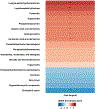Presurgical blood metabolites and risk of postsurgical pelvic pain in young patients with endometriosis
- PMID: 35367064
- PMCID: PMC9149031
- DOI: 10.1016/j.fertnstert.2022.02.012
Presurgical blood metabolites and risk of postsurgical pelvic pain in young patients with endometriosis
Abstract
Objective: To identify metabolites in presurgical blood associated with risk of persistent postsurgical pelvic pain 1 year after endometriosis surgery in adolescent and young adult patients.
Design: Prospective observational study within the Women's Health Study: From Adolescence to Adulthood, a US-based longitudinal cohort of adolescents and women enrolled from 2012-2018.
Setting: Two tertiary care hospitals.
Patient(s): Laparoscopically confirmed endometriosis patients (n = 180) with blood collected before their endometriosis surgery. Of these, 77 patients additionally provided blood samples 5 weeks to 6 months after their surgery. We measured plasma metabolites using liquid chromatography tandem mass spectrometry, and a total of 390 known metabolites were included in our analysis.
Intervention(s): None.
Main outcome measure(s): Persistent postsurgical pelvic pain, defined as severe, life-impacting pelvic pain 1 year after endometriosis surgery.
Result(s): Most patients (>95%) were at stage I/II of the revised American Society for Reproductive Medicine classification. Their average age at diagnosis was 18.7 years, with 36% reporting persistent postsurgical pelvic pain. Of the 21 metabolites in presurgical blood that were associated with risk of persistent postsurgical pelvic pain, 19 metabolites, which were mainly lipid metabolites, were associated with increased risk. Only 2 metabolites-pregnenolone sulfate (odds ratio = 0.64, 95% confidence interval = 0.44-0.92) and fucose (odds ratio = 0.69, 95% confidence interval = 0.47-0.97)-were associated with decreased risk. Metabolite set enrichment analysis revealed that higher levels of lysophosphatidylethanolamines (false discovery rate = 0.01) and lysophosphatidylcholines (false discovery rate = 0.01) in presurgical blood were associated with increased risk of persistent postsurgical pelvic pain.
Conclusion(s): Our results suggest that dysregulation of multiple groups of lipid metabolites may play a role in the persistence of pelvic pain postsurgery among young endometriosis patients.
Keywords: Adolescent; biomarkers; endometriosis; metabolomics; postsurgical pelvic pain.
Copyright © 2022 American Society for Reproductive Medicine. Published by Elsevier Inc. All rights reserved.
Conflict of interest statement
Figures


Similar articles
-
Pre- and postsurgical medical therapy for endometriosis surgery.Cochrane Database Syst Rev. 2020 Nov 18;11(11):CD003678. doi: 10.1002/14651858.CD003678.pub3. Cochrane Database Syst Rev. 2020. PMID: 33206374 Free PMC article.
-
Pain typology and incident endometriosis.Hum Reprod. 2015 Oct;30(10):2427-38. doi: 10.1093/humrep/dev147. Epub 2015 Aug 11. Hum Reprod. 2015. PMID: 26269529 Free PMC article.
-
Plasma proteomic profiles of pain subtypes in adolescents and young adults with endometriosis.Hum Reprod. 2023 Aug 1;38(8):1509-1519. doi: 10.1093/humrep/dead099. Hum Reprod. 2023. PMID: 37196326 Free PMC article.
-
Surgical treatment of endometriosis: location and patterns of disease at reoperation.Fertil Steril. 2010 Jan;93(1):57-61. doi: 10.1016/j.fertnstert.2008.09.085. Epub 2008 Nov 11. Fertil Steril. 2010. PMID: 19006792
-
Laparoscopic surgery for endometriosis.Cochrane Database Syst Rev. 2020 Oct 23;10(10):CD011031. doi: 10.1002/14651858.CD011031.pub3. Cochrane Database Syst Rev. 2020. PMID: 33095458 Free PMC article.
Cited by
-
An insight into gut microbiota and metabolites in the mice with adenomyosis.Front Cell Infect Microbiol. 2023 Feb 27;13:1075387. doi: 10.3389/fcimb.2023.1075387. eCollection 2023. Front Cell Infect Microbiol. 2023. PMID: 36923594 Free PMC article.
-
Predicting Individual Pain Sensitivity Using a Novel Cortical Biomarker Signature.JAMA Neurol. 2025 Mar 1;82(3):237-246. doi: 10.1001/jamaneurol.2024.4857. JAMA Neurol. 2025. PMID: 39869323 Free PMC article.
-
Bidirectional causality between the levels of blood lipids and endometriosis: a two-sample mendelian randomization study.BMC Womens Health. 2024 Jul 4;24(1):387. doi: 10.1186/s12905-024-03213-w. BMC Womens Health. 2024. PMID: 38965508 Free PMC article.
-
Plasma metabolites associated with endometriosis in adolescents and young adults.Hum Reprod. 2025 May 1;40(5):843-854. doi: 10.1093/humrep/deaf040. Hum Reprod. 2025. PMID: 40107296
-
Innovations in acute and chronic pain biomarkers: enhancing diagnosis and personalized therapy.Reg Anesth Pain Med. 2025 Feb 5;50(2):110-120. doi: 10.1136/rapm-2024-106030. Reg Anesth Pain Med. 2025. PMID: 39909549 Free PMC article. Review.
References
-
- Zondervan KT, Becker CM, Missmer SA. Endometriosis. N Engl J Med 2020;382:1244–56. - PubMed
-
- Abbott J, Hawe J, Hunter D, Holmes M, Finn P, Garry R. Laparoscopic excision of endometriosis: a randomized, placebo-controlled trial. Fertil Steril 2004;82:878–84. - PubMed
-
- Gerszten RE, Wang TJ. The search for new cardiovascular biomarkers. Nature 2008;451:949–52. - PubMed
Publication types
MeSH terms
Substances
Grants and funding
LinkOut - more resources
Full Text Sources
Medical

